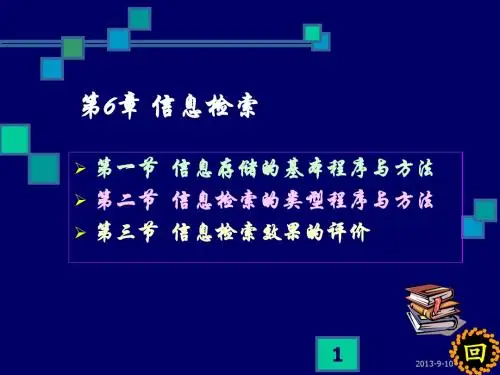【数据库】ch6-theory-2
- 格式:ppt
- 大小:327.00 KB
- 文档页数:33
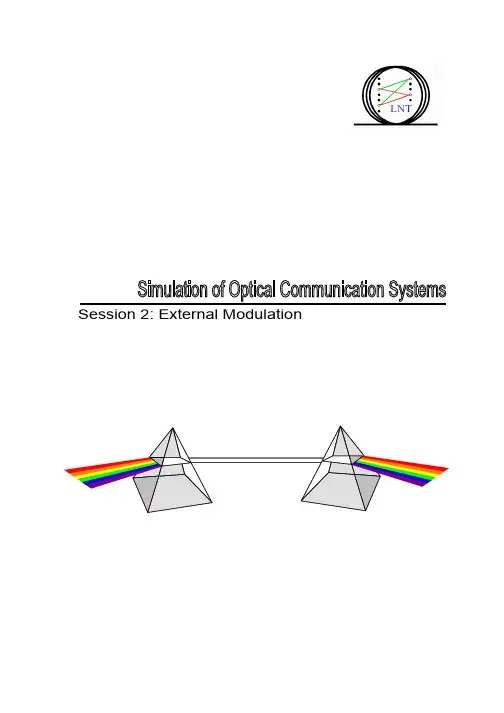
Copyright notice© 2006-2008 byWired Communications Group (Fachgebiet Leitungsgebundene Übertragungstechnik) Institute for Communications Engineering (LNT)Technische Universität München (TUM)D-80290 MünchenGermanyPhone: +49 89 23472ContentsTheoretical Background (4)1. Mach-Zehnder Modulators (4)1.1. Physical Background and Mathematical Modeling (4)1.2. Pulse shaping and Modulation (8)1.2.1. NRZ (8)1.2.2. RZ (9)1.2.3. CSRZ (13)1.2.4. Duobinary (13)Bibliography (14)Theoretical BackgroundAs we have seen in the first session of this simulation lab, it is difficult to generate intensity modulation by direct modulation of a semiconductor laser for high-speed communications (e.g. > 5 Gbit/s) due to the limited bandwidth of direct modulation. This problem can be solved if an additional optical component is introduced. The laser is then operated with a constant injection current, simply generating a constant light carrier. This carrier is modulated in a new device, the so-called external modulator . The most frequently used external modulator is applying a Mach-Zehnder interferometer structure, and is therefore called Mach-Zehnder Modulator (MZM). This device is investigated in the following.1. Mach-Zehnder Modulators1.1. Physical Background and Mathematical ModelingIn a MZM the incoming non-modulated carrier according to ˆ()c j t in E t E e ω=⋅ is first split up into two optical paths (see Fig. 1).Figure 1: General structure of a Mach-Zehnder Modulator (dual-drive configuration)The incoming light power is split up in the left Y-branch according to the power splittingratios 21κ and 211κ−, i.e. 11ˆˆ(0)in Ez E κ==⋅, ˆˆ(0)E z E ==. The waveguide is made of a special material showing a strong electro-optic effect, typically Lithium-Niobate (LiNbO 3). Due to this electro-optical effect the refractive index of LiNbO 3changes with an externally applied electrical voltage u(t) according to0()().EO n t n u t ς=+⋅ (2.1)Here n 0 is the refractive index without external field, EO ς models the strength of the electro-optical effect. As a consequence, the phase velocity of a propagating electrical wave is modified as /n c c n =, and thus the wave number k changes according to ()/n k c n ω=⋅, where c is the speed of light in vacuum. Therefore the phase shift of the waves propagating in branch 1 and 2 of the waveguide can be tuned by the applied voltages u 1(t) and u 2(t), respectively, resulting in111ˆˆ()(0)j E z L E z e ϕ−∆===⋅ and 2ˆˆ()(0)j E z L E z e ϕ−∆===⋅, (2.2)Session 22-5with ()11n k u L ϕ∆=⋅and ()22n k u L ϕ∆=⋅, respectively. The attenuation of the waveguidesis neglected for the sake of simplicity. 1ˆEand ˆE are then combined at the output of the device according to212ˆˆˆ()().out E E z L E z L κ=⋅=+= (2.3)22κ and 221κ− are the power splitting ratios of the Y-branch on the right-hand side inFig. 1. This results finally in the output field ()out E t according to1212ˆ()c j t j j out E t E e e e ωϕϕκκ−∆−∆ =⋅⋅+⋅. (2.4)Under the condition of symmetrical splitting, i.e. 221212κκ==, we get121ˆ().2c j t j j in E t E e e e ωϕϕ−∆−∆ =⋅+⋅ (2.5)It can be seen from (2.5) that, depending on the relative phases ∆ϕ1 and ∆ϕ2, neither amplitude nor phase of the outcoming field are modified. This becomes more obvious after a simple modification of (2.5), resulting in121212122221221ˆ()2ˆ cos .2c c j j j j t out j j t in E t E e e e e E e e ϕϕϕϕϕϕωϕϕωϕϕ∆−∆∆−∆∆+∆−−∆+∆− =⋅+⋅⋅= ∆−∆ =⋅⋅⋅(2.6)There is a linear relation between the phase shift difference ∆ϕ1 - ∆ϕ2 and the voltage difference u 1-u 2. Also, it is important to notice that these quantities are usually time-dependent. This leads us to()()()()()1212.u t u t t t u t V V πππϕϕπ−∆−∆=⋅=⋅ (2.7)The parameter V π denotes the voltage difference u(t) = u 1(t)-u 2(t) that generates a relative phase shift of π between upper and lower branch of the MZM. The phase term in (2.6) is now re-written as()()()()121222,u t u t t t j jV eeππϕϕ− ∆+∆−Θ⋅ −= where ()()()()()()()()12121212t t u t u t t t u t u t ϕϕϕϕ∆+∆+Θ==∆−∆−. (2.8)Substituting (2.7) and (2.8) into (2.6) finally results in()()()()12212ˆ()cos .2c u t u t j V j t out in u t u t E t E ee V ππωππ−−Θ⋅⋅− =⋅⋅⋅⋅(2.9)Lab on Simulation of Optical Communication Systems2-6 The parameter Θ is called the asymmetry factor of the dual-drive MZM. To make Θ a time-independent constant, u 1(t) and u 2(t) can no longer be selected independently, but are constrained by()()12()()()1,()1,22u t u t u t u t =⋅Θ+=⋅Θ− (2.10)with the definition: 1 1.−≤Θ≤The way the selection of the asymmetry factor Θ acts on u 1 and u 2 is depicted in Figure 2.Figure 2: Effect of the asymmetry factor ΘAs we can see from (2.9), if Θ = 0 is selected, i.e. u 1(t) = u(t)/2, u 2(t) = -u(t)/2, the modulator generates pure amplitude (or intensity) modulation without any time-dependent modification of the signal phase. If asymmetry is introduced by selecting Θ ≠ 0, the intensity modulation is not modified; however, an additional phase modulation is generated. This parasitical, time-dependent phase modulation modifies the instantaneous frequency of the light wave according to()().2c du t t V dtππωωΘ=−⋅⋅ (2.11)As we know from Session 1 of this course, this frequency chirp, i.e. the deviation ∆f(t) = ∆ω(t) / 2π of the instantaneous signal from the carrier frequency, has a negative influence on the propagating signal due to the chromatic dispersion of the fiber. Therefore, strong efforts are made generally to reduce this chirp to negligible values. As we could see above, selecting Θ = 0, i.e. u 2(t) = -u 1(t), results in chirp-free intensity modulation. This operation of the dual-drive MZM is called push-pull mode .Another solution is a re-design of the Mach-Zehnder modulator: If the poles of the applied voltage are changed according to Figure 3, the condition u 2(t) = -u 1(t) is met automatically. In this single-drive configuration the voltage difference u(t) is directly impressed on the modulator. In this session, we will only be using dual-drive MZMs.Session 22-7Figure 3: Single-drive Mach-Zehnder ModulatorIf the dual-drive MZM is operated in chirp-free mode, the electrical output field is simplygiven as()ˆˆ()cos ().2c c j t j t out inout u t E t E e E t e V ωωππ =⋅⋅⋅=⋅(2.12)From (2.12) it can be seen that the amplitude ˆ()E t depends on the input voltage u(t) according to a cosine function. The power P(t) of the modulated carrier is therefore calculated as222()ˆˆ()()()cos .2out in u t P t E t E t V ππ=⋅⋅ ∼(2.13)The curves relating ˆoutE and P with u are depicted in Figures 4 and 5. Figure 4: ˆoutE (normalized) as a function of input voltage u 1-1-1 1 2 3 41X X X 23Lab on Simulation of Optical Communication Systems2-8Figure 5: P (normalized) as a function of input voltage uThe operation point of the MZM is defined by applying a specific bias voltage. The points 1 (trough ), 2 (quadrature ) and 3 (crest ) marked in Figure 4 are used to generate specific optical modulation schemes. Of course any other adequate operation point could be selected due to the periodicity of the curves.1.2. Pulse shaping and ModulationDespite their simple working principle, Mach-Zehnder modulators are extremely versatile and can be used to create many different pulse shapes and modulation formats at very high bit rates. The curves depicted in Figures 4 and 5 are the key to creating the various transmitter configurations.In this lab session, we will concentrate on the pulse shapes Non-Return-to-Zero (NRZ ), Return-to-Zero (RZ ) with various duty cycles and Carrier-Suppressed Return-to-Zero (CSRZ ). As a modulation format, we will consider On-Off-Keying (OOK ). However, if you have some time left at the end of the session, you can try and use Mach-Zehnder Modulators to set up a DPSK transmitter.1 Lastly, we are going to experiment with a duobinary transmitter. Although duobinary is commonly referred to as a modulation scheme, strictly speaking, it is achieved by a combination of a logical precoder (so-called line coding ) with Amplitude Shift Keying (ASK).21.2.1. NRZA single MZM can be used to produce an NRZ OOK signal. The MZM is biased in the quadrature point, i.e. /2Bias u V π=−. The driving or modulation voltage mod u has a range of V π and produces NRZ pulses corresponding to the binary data stream.3 Table 1 summarizes these parameters. In Figure 6, the modulation voltage is depicted along the time axis (which is drawn shifted by Bias u ) for the bit sequence …010011….1There is a multitude of other pulse shapes (e.g. Chirped RZ – CRZ pulses) and modulation schemes (e.g. multilevel ASK, DPSK, DQPSK, D8-PSK, as well as combinations of ASK and PSK, etc.), whosetransmission properties are in the center of research attention. Some of these advanced transmission systems are already deployed in undersea optical communication links. The transmitter structures covered in this lab session, however, are still by far the most popular in current systems. 2Line coding (for which AMI codes are another example) is a technique used to equip the signal with certain desired properties in the time or frequency domain (spectral shaping ). It must be distinguished from channel coding, where redundancy is added to the signal in order to combat transmission errors at the receiver. 3Bias u can be regarded as the constant offset (bias) of u(t). Hence mod ()()Bias u t u u t =+.1-1 1 2 3 4Session 22-9Table 1: Voltage Parameters of a MZM producing OOK NRZ modulation1.2.2. RZCompared to the simpler NRZ pulses, Return-to-Zero (RZ) pulses have several advantages:• In long sequences of ones , RZ pulses still allow the receiver to recover the signal clock.• For the same pulse energy, the peak power is higher in RZ than in NRZ pulses, resulting in a higher SNR at the sampling instant.• Depending on the system configuration, RZ pulses can yield a better systemperformance than NRZ pulses. It is, however, difficult to make general statements about the performance gain of RZ over NRZ, as this gain depends on many system parameters such as signal power, filter bandwidths, fiber nonlinearities, dispersion1-1uV π-1 1 2 3 4Lab on Simulation of Optical Communication Systems2-10map and data rate. As a rough rule, it can be said that RZ plays out its advantages with increasing data rates and signal powers (i.e. higher fiber nonlinearities) [5]. These advantages, however, come at the cost of an increased transmitter complexity. To generate a signal with RZ pulses, a setup employing two MZMs is used (Figure 7). The first MZM, called the pulse carver (PC), is generating a train of identical pulses, which serve as an input to the second MZM, the data or gating modulator (DM). The purpose of the DM, which is configured as an NRZ OOK modulator as introduced in the previous section, is simply to block or let pass single pulses depending on the data to be transmitted.Figure 7: Setup of RZ transmitterThe pulse carver is driven by a cosine function. Depending on the bias voltage and the modulation voltage’s range and frequency, different types of RZ pulses can be generated. RZ pulses are characterized by their duty cycle , which is the pulse’s full width at half intensity relative to the bit slot duration. RZ33 denotes an RZ pulse with 33% duty cycle; RZ50 has 50% duty cycle. In contrast to these two, RZ67 pulses have an alternating field sign. They are covered in the next section.RZ50 Pulse GenerationTo produce RZ pulses with 50% duty cycle, the PC is driven with the parameters given in Table 2.Table 2: Voltage Parameters of a MZM producing RZ 50 pulsesQuestionWhat are A and B in ()mod cos u A B t =⋅⋅ if we want to produce RZ50 pulses for a 10Gbit/ssignal? Sketch the modulation voltage versus time in Figure 8.mod ()(),bias u t u u t =+ where /2bias u V π= andmod ()/2cos 210 GHz B A u t V t ππ=⋅⋅⋅Figure 8: Generation of RZ50 pulses (E (solid) and P (dashed) normalized)RZ33 Pulse GenerationRZ33 pulses are even narrower in the time domain than RZ50 pulses and accordingly have a broader spectrum. They can be generated using the parameters given in Table 3.Table 3: Voltage Parameters of a MZM producing RZ 33 pulsesBias u 0 (crest)mod u function Cosinemod u frequency Half the bit frequency (e.g. 5 GHz for a 10 Gbit/s signal) mod u range[];V V ππ−1.2.3. CSRZAt V π, the power P is minimum and the electrical field changes its sign. When the bias voltage is set to this point, a pulse carver driven by a cosine function will produce pulses that have alternating field signs. Therefore, the generated signal is DC-free (in the electric field domain). In the frequency spectrum, this property corresponds to an absence of discrete spectral components at the carrier frequency. For that reason, these pulses are called Carrier-Suppressed RZ (CSRZ). The parameters used to create CSRZ pulses are given in Table 4. The duty cycle of CSRZ pulses is 67%, so they are also called RZ67.Table 4: Voltage Parameters of a MZM producing CSRZ pulsesBias u V π (trough)mod u function Cosinemod u frequency Half the bit frequency (e.g. 5 GHz for a 10 Gbit/s signal) mod u range[];V V ππ−CSRZ pulses have the advantage of being quite robust against ISI caused by dispersion. To understand why, imagine two neighboring pulses spreading in time such that they overlap partly. Adjacent CSRZ pulses have contrary signs, so that ideally, they completely cancel. In the lab, this can be observed from a larger eye opening compared to other RZ pulses.1.2.4. DuobinaryDuobinary modulation is, strictly speaking, not a modulation format, but rather 3-level Amplitude Shift Keying (ASK) with a logical precoder. The values transmitted are 0P = (i.e. u V π=) for a logical zero, and 1normalized P = (i.e. 0u = or 2u V π=) for a logical one. The data modulator is therefore driven by a three-level (0,,2u V V ππ=) electrical NRZ signal. The transformation of the binary data sequence to a ternary sequence is achieved by a logical precoder, whose coding rule is as follows: • A logical zero is always coded as 0.• A logical one is coded as +1 or -1. If an odd number of zeros is transmitted, thesign of the following one is changed.The block diagram of a duobinary coder is depicted in Figure 9. Figure 9: Block diagram of duobinary precoderFor the system in Figure 9 to make sense, two conventions are important:The output of the XOR element is bipolar, i.e. a 1 is output as +1, a 0 as -1.The output of the total system will have an absolute amplitude of 2, i.e. to obtainthe duobinary code described above, we would have to divide by 2.The block diagram in Figure 9, however, illustrates the way duobinary signals are generated in OptiSystem . The first dotted box corresponds to the OptiSystem element Binary NOT , the second to the element Duobinary Precoder , and the third box corresponds to the Duobinary Pulse Generator .The example given in Table 5 will help clarify the principle.Table 5: Example of duobinary line codingA 0 1 0 1 1 1 1 0 0 1 1 0 0 0 1 1 0 1B 1 0 1 0 0 0 0 1 1 0 0 1 1 1 0 0 1 0C 1 1 -1 -1 -1 -1 -1 1 -1 -1 -1 1 -1 1 1 1 -1 -1 D0 +2 0 -2 -2 -2 -2 0 0 -2 -2 0 0 0 +2 +2 0 -2The main advantage of duobinary modulation is its dispersion tolerance. In particular, isolated zeros (such as in …101…) cause the sign of the ones to change. Because of the opposed field signs, the neighboring pulses ideally cancel when leaking into the zero bit slot.Duobinary coding is usually used with NRZ pulses. Therefore, only one MZM is required at the transmitter. Because of the broad NRZ pulses used, duobinary signals have a narrow spectrum suitable for WDM systems with a small channel separation, which is another advantage.QuestionWhat bias voltage Bias u do you choose for duobinary modulation? Which values does mod u take (compare with Figure 6)?Bias u V π= (trough){}mod ,0,u V V ππ∈−Bibliography[1] N. Hanik; Optical Communication Systems, Lecture Notes at Technische UniversitätMünchen (TUM), 2008[2] G.P. Agrawal; Fiber-Optic Communication Systems, Third Edition, John Wiley &Sons, New York, 2002[3] E. Voges, K. Petermann (eds.); Optische Kommunikationstechnik, Springer, Berlin,2002[4] I. Kaminov, T. Li (eds.), Optical Fiber Telecommunications IV, Academic Press, SanDiego, 2002[5] P.J. Winzer, R.-J. Essiambre, Advanced Modulation Formats, Proceedings of theIEEE, Vol. 94, No. 5, pp. 952-985, May 2006。
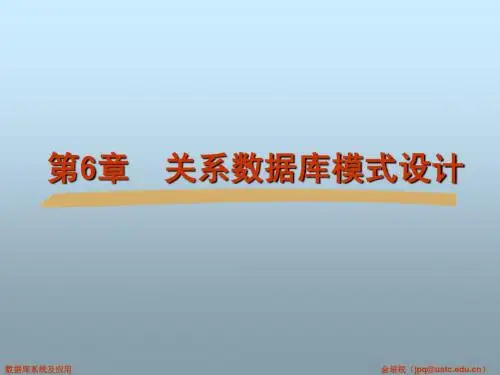
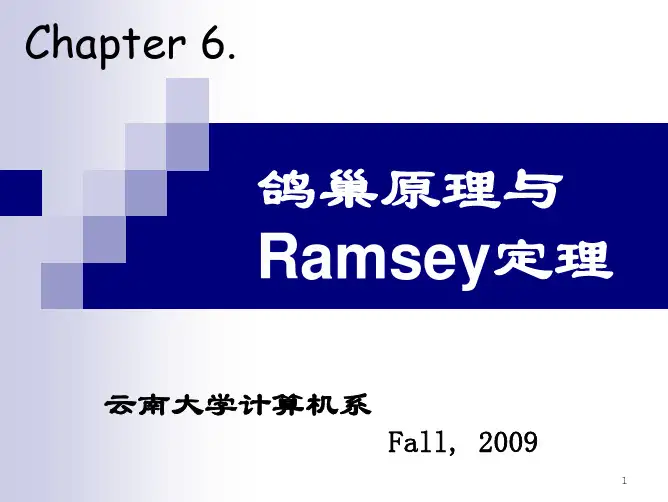
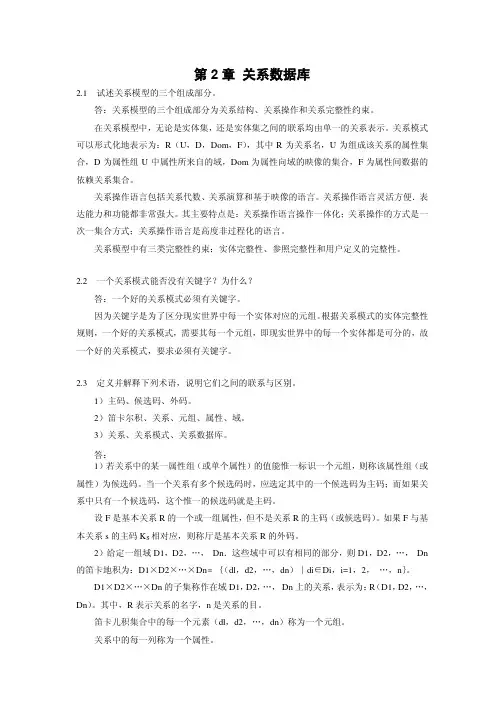
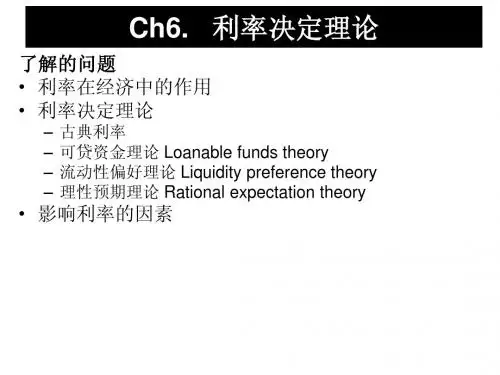

(五) 纤维粘连蛋白二、免疫球蛋白超家族三、selectin家族(一) selectin分子的基本结构(二) selectin家族的组成(三) selectin分子识别的配体四、Cadherin家族(一) Cadherin分子的结构(二) Cadherin家族的组成和分布(三) Cadherin分子识别的配体五、其它未归类的粘附分子(一) selectin分子结合的配体(二) CD44第二节 粘附分子表达的调节一、粘附分子构型改变影响细胞的粘附作用(一) LFA-1分子构型改变对其粘附作用的影响(二) 其它粘附分子构型的改变对粘附作用的影响二、细胞粘附分子表达数量改变对粘附作用的调节第三节 粘附分子的功能一、炎症过程中白细胞与血管内皮细胞的粘附二、粘附分子与淋巴细胞的归巢(一) T细胞前体向胸腺的归巢(二) 淋巴细胞向外周淋巴器官的归巢(三) 淋巴细胞向非淋巴组织的归巢(四) 淋巴细胞归巢过程中激活粘附作用的分子三、粘附分子参与免疫细胞的识别作用四、粘附分子参与细胞发育、分化、附着及移动(一) 粘附分子参与细胞间的附着(二) 粘附分子参与细胞与基质的附着(三)粘附分子参与细胞的移动五、粘附分子与肿瘤(一) 粘附分子与肿瘤的浸润与转移(二) 粘附分子对杀伤细胞杀伤肿瘤细胞的影响(三) 粘附分子与肿瘤的诊断六、粘附分子与凝血(一) 粘附分子与动脉凝血(二) 粘附分子与静脉凝血七、粘附分子与细胞内信号传导(一) 粘附分子与细胞内酪氨酸磷酸化(二) 粘附分子与细胞膜磷酯酰肌醇代谢第四节 可溶性粘附分子(一) 可溶性L-selectin(sL-selectin)(二) 可溶性P-selectin(sP-selectin)(三) 可溶性E-selectin(sE-selectin)(四) 可溶性ICAM-1(sICAM-1)(五) 可溶性VCAM-1(sVCAM-1)参考文献(三) Cadherin分子识别的配体五、其它未归类的粘附分子(一) selectin分子结合的配体(二) CD44一、粘合素超家族国内将integrin译为粘合素、整合素等,本书暂命名为粘合素。

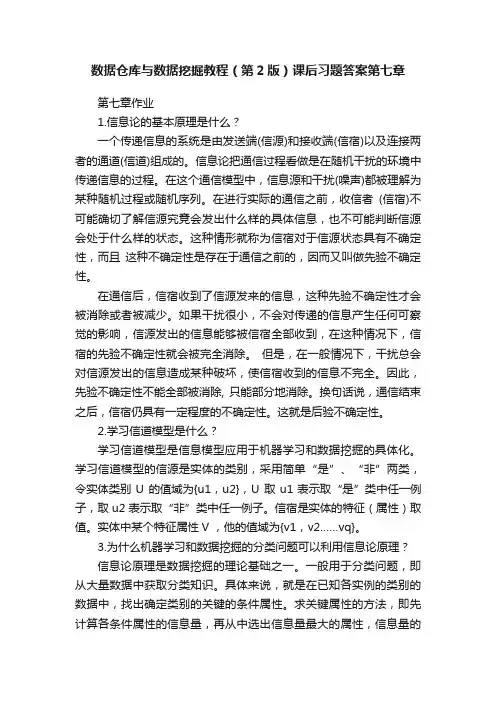
数据仓库与数据挖掘教程(第2版)课后习题答案第七章第七章作业1.信息论的基本原理是什么?一个传递信息的系统是由发送端(信源)和接收端(信宿)以及连接两者的通道(信道)组成的。
信息论把通信过程看做是在随机干扰的环境中传递信息的过程。
在这个通信模型中,信息源和干扰(噪声)都被理解为某种随机过程或随机序列。
在进行实际的通信之前,收信者(信宿)不可能确切了解信源究竟会发出什么样的具体信息,也不可能判断信源会处于什么样的状态。
这种情形就称为信宿对于信源状态具有不确定性,而且这种不确定性是存在于通信之前的,因而又叫做先验不确定性。
在通信后,信宿收到了信源发来的信息,这种先验不确定性才会被消除或者被减少。
如果干扰很小,不会对传递的信息产生任何可察觉的影响,信源发出的信息能够被信宿全部收到,在这种情况下,信宿的先验不确定性就会被完全消除。
但是,在一般情况下,干扰总会对信源发出的信息造成某种破坏,使信宿收到的信息不完全。
因此,先验不确定性不能全部被消除, 只能部分地消除。
换句话说,通信结束之后,信宿仍具有一定程度的不确定性。
这就是后验不确定性。
2.学习信道模型是什么?学习信道模型是信息模型应用于机器学习和数据挖掘的具体化。
学习信道模型的信源是实体的类别,采用简单“是”、“非”两类,令实体类别U 的值域为{u1,u2},U 取u1表示取“是”类中任一例子,取u2表示取“非”类中任一例子。
信宿是实体的特征(属性)取值。
实体中某个特征属性V ,他的值域为{v1,v2……vq}。
3.为什么机器学习和数据挖掘的分类问题可以利用信息论原理?信息论原理是数据挖掘的理论基础之一。
一般用于分类问题,即从大量数据中获取分类知识。
具体来说,就是在已知各实例的类别的数据中,找出确定类别的关键的条件属性。
求关键属性的方法,即先计算各条件属性的信息量,再从中选出信息量最大的属性,信息量的计算是利用信息论原理中的公式。
4自信息:单个消息ui 发出前的不确定性(随机性)称为自信息。
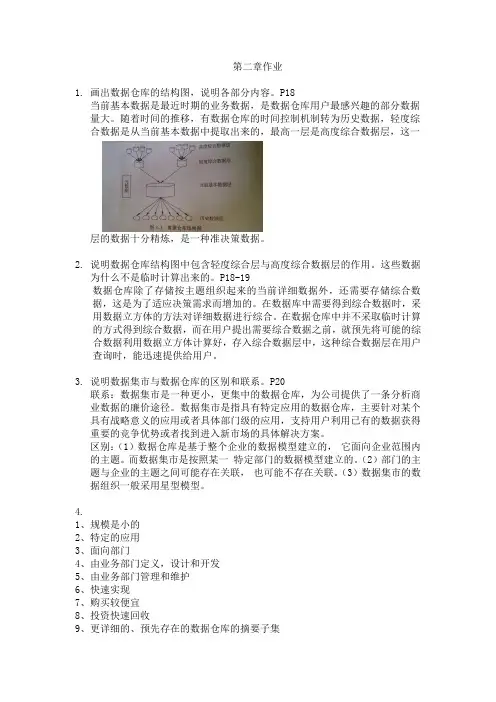
第二章作业1.画出数据仓库的结构图,说明各部分内容。
P18当前基本数据是最近时期的业务数据,是数据仓库用户最感兴趣的部分数据量大。
随着时间的推移,有数据仓库的时间控制机制转为历史数据,轻度综合数据是从当前基本数据中提取出来的,最高一层是高度综合数据层,这一层的数据十分精炼,是一种准决策数据。
2.说明数据仓库结构图中包含轻度综合层与高度综合数据层的作用。
这些数据为什么不是临时计算出来的。
P18-19数据仓库除了存储按主题组织起来的当前详细数据外,还需要存储综合数据,这是为了适应决策需求而增加的。
在数据库中需要得到综合数据时,采用数据立方体的方法对详细数据进行综合。
在数据仓库中并不采取临时计算的方式得到综合数据,而在用户提出需要综合数据之前,就预先将可能的综合数据利用数据立方体计算好,存入综合数据层中,这种综合数据层在用户查询时,能迅速提供给用户。
3.说明数据集市与数据仓库的区别和联系。
P20联系:数据集市是一种更小,更集中的数据仓库,为公司提供了一条分析商业数据的廉价途径。
数据集市是指具有特定应用的数据仓库,主要针对某个具有战略意义的应用或者具体部门级的应用,支持用户利用已有的数据获得重要的竞争优势或者找到进入新市场的具体解决方案。
区别:(1)数据仓库是基于整个企业的数据模型建立的,它面向企业范围内的主题。
而数据集市是按照某一特定部门的数据模型建立的。
(2)部门的主题与企业的主题之间可能存在关联,也可能不存在关联。
(3)数据集市的数据组织一般采用星型模型。
4.1、规模是小的2、特定的应用3、面向部门4、由业务部门定义,设计和开发5、由业务部门管理和维护6、快速实现7、购买较便宜8、投资快速回收9、更详细的、预先存在的数据仓库的摘要子集10、可升级到完整的数据仓库5.独立型数据集市直接从操作型环境获取数据,从属型数据集市从企业级数据仓库获取数据,带有从属型数据集市的体系结构。
6.原因:仓库管理:安全和特权管理;跟踪数据的更新;数据质量检查;管理和更新元数据;审计和报告数据仓库的使用和状态;删除数据;复制、分割和分发数据;备份和恢复;存储管理。
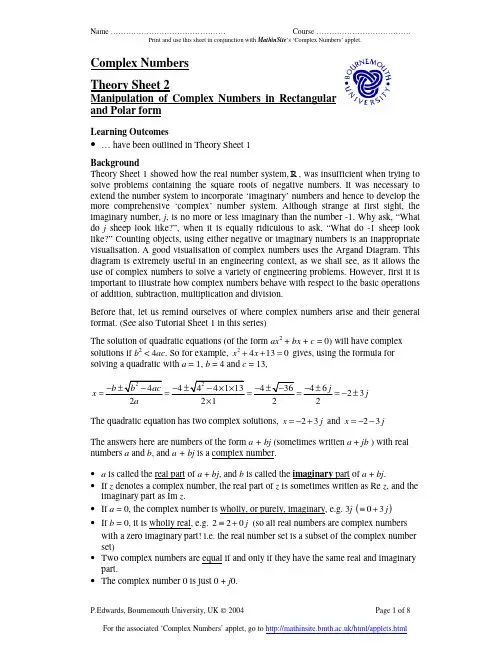
Complex NumbersTheory Sheet 2Manipulation of Complex Numbers in Rectangular and Polar formLearning Outcomes• … have been outlined in Theory Sheet 1BackgroundTheory Sheet 1 showed how the real number system, , was insufficient when trying to solve problems containing the square roots of negative numbers. It was necessary to extend the number system to incorporate ‘imaginary’ numbers and hence to develop the more comprehensive ‘complex’ number system. Although strange at first sight, the imaginary number, j , is no more or less imaginary than the number -1. Why ask, “What do j sheep look like?”, when it is equally ridiculous to ask, “What do -1 sheep look like?” Counting objects, using either negative or imaginary numbers is an inappropriate visualisation. A good visualisation of complex numbers uses the Argand Diagram. This diagram is extremely useful in an engineering context, as we shall see, as it allows the use of complex numbers to solve a variety of engineering problems. However, first it is important to illustrate how complex numbers behave with respect to the basic operations of addition, subtraction, multiplication and division.Before that, let us remind ourselves of where complex numbers arise and their general format. (See also Tutorial Sheet 1 in this series)The solution of quadratic equations (of the form ax 2 + bx + c = 0) will have complex solutions if b 2 < 4ac . So for example, 24130x x ++= gives, using the formula for solving a quadratic with a = 1, b = 4 and c = 13,46232j x j −±=====−±The quadratic equation has two complex solutions, 23x j =−+ and 23x j =−−The answers here are numbers of the form a + bj (sometimes written a + jb ) with realnumbers a and b , and a + bj is a complex number.• a is called the real part of a + bj , and b is called the imaginary part of a + bj .• If z denotes a complex number, the real part of z is sometimes written as Re z , and the imaginary part as Im z .• If a = 0, the complex number is wholly, or purely, imaginary, e.g. 3j ()03j ≡+• If b = 0, it is wholly real, e.g. 220j ≡+ (so all real numbers are complex numbers with a zero imaginary part! i.e. the real number set is a subset of the complex number set)• Two complex numbers are equal if and only if they have the same real and imaginary part.• The complex number 0 is just 0 + j 0.Manipulation of Complex Numbers in Rectangular formPractically the first operations we performed with numbers in early schooldays were addition, subtraction, multiplication and division. As we were introduced to each new number system, we learned how to perform these operations. So again, with complex numbers, we need to be able to know how to add, subtract, multiply and divide.It is safe to assume that the ordinary rules of arithmetic apply, so that the following rules for addition, subtraction and multiplication apply to any two complex numbers of the form z 1 = a + bj and z 2 = c + dj :Addition: z 1 + z 2 = (a + bj ) + (c + dj ) = (a + c ) + (b + d )jSubtraction:z 1 - z 2 = (a + bj ) - (c + dj ) = (a - c ) + (b - d )j Multiplication: z 1. z 2 = (a + bj ).(c + dj ) = ac + adj + bcj +bdj 2but remember j 2 = -1, soz 1. z 2 = (a + bj )(c + dj ) = (ac − bd ) + (bc + ad )jNote:• In addition (or subtraction), add (or subtract) corresponding real parts and imaginary parts• Multiplication is carried out in exactly the same way that you would multiply, for example, (x + 2)(2x – 3)• don’t try to remember these formulae, work each one out ‘on the fly’.As you become more adept at such calculations, it becomes possible to write down the answers directly. The first three examples that follow are fairly straightforward – just beware of “minus minuses”!Examples of Complex Addition and Subtraction1. (2 + 3 j ) + (6 - j 5) = 8 – 2j (remember a + jb = a + bj )2.j3.()(5665j j −=−++There’s nothing wrong with leaving your answer in this square root format – although you can write it in decimals if you really want to.Examples of Complex Multiplication1. ()()2563j j +−=12 – 6j + 30j – 15j 2 12 +24j -15(-1) = 27 + 24j2. 3j (4 – 6j ) = 12j -18j 2 = 18 + 12 j(remember j 2 = -1)Before looking at complex division it is necessary to first consider …The Complex Conjugate of z , z(i.e. just change the sign of the imaginary part)Example : If z = - 2 – 3j then z =- 2 + 3j .Note that these were the two roots of the quadratic equation on page 1 of this tutorial sheet. In fact, when a quadratic equation has complex solutions these always occur as complex conjugate pairs.If z = a + bj , then the complex conjugate , z , is z a bj =−Obviously, complex conjugating twice returns us to the original number: z = z .On its own, the complex conjugate doesn’t appear useful, but it has one important property that allows us to perform complex division, that is, z z is always wholly real .Proof : let z be any complex number a + bj so that z a bj =−, so()()22222z z a bj a bj a abj abj b j a b =+−=−+−=+ - wholly realNote that a complex number multiplied by its own complex conjugate is easily found from(real part)2 + (imaginary part)2In general this will always look like:If (c + jd ) ≠ 0 + j 0 then a + bjc +dj can be calculated by writinga + bj c + dj as a + bj c -dj c + dj c - dj× = ac + bdc 2+ d 2 + j bc − ad c 2 + d 2A Bj ≡+ So when two complex numbers are divided, the result is a complex number. Again, don’t try to remember this formula, work each case out ‘on the fly’.Example of Complex Division3564j j −=−+3564381838181991996464361652262626j j j j j j j j −−−−+−+−+×====−+−+−−+Complex Numbers in Polar FormIn Tutorial Sheet 1 we saw that complex numbers can be visualised in Rectangular Form (or Cartesian Form) as points in a 2-dimensional plane (an Argand Diagram), unlike real numbers, which exist only along a 1-dimensional line.Rectangular form is not the only way to represent a complex number on an Argand Diagram. Instead of merely a point, a complex number can be represented by a directed line segment (arrow) from the origin of the Argand Diagram to the point itself. So 2 + 3j can also be represented thus:Complex division is always performed by multiplying both numerator and denominator of the complex division by the complex conjugate of the numerator .This will ensure a real denominator.So a complex number such as 2 + 3j exists at a point reached by moving +2 in the ‘real’ direction and +3 in the imaginary direction.angle (to the positive real axis),θ.One consequence of being able to express complex numbers in polar form is that they can be used to solve 2-dimensional vector and phasor problems.Conversion from Rectangular to Polar form and vice versaConsider the following Argand Diagram in which the complex number z = a + bj is illustrated with both its rectangular and polar‘coordinates’ shown.Dropping a vertical line from the end of the complexnumber to the real axis produces a right-angled triangle in which the non-hypotenuse sides are a and b and the hypotenuse is r . The angle measured from the positive real axis is denoted θ.Applying trigonometrical ratios to this triangle givescos and sin a br rθθ== or cos and sin a r b r θθ==So, the complex number written in Rectangular Form, z = a + bj , can be written in Polar Form as cos sin z r jr θθ=+ of course, with a common factor of r , this becomes()cos sin z r j θθ=+. This is often abbreviated to z r θ=∠ or ,z r θ=Needless to say, it is possible to determine a complex number’s Rectangular form from its polar form. Returning to the triangle above, Pythagoras’ Theorem givesr =1tan b a θ−=NOTE: When using this latter expression, it is important to determine the correct quadrant for θ.To this end it is always advisable to sketch the Argand Diagram to ensure the correct angle is found.In summary thenRectangular Form: z = a + bjPolar Form:()cos sin z r j θθ=+, or z r θ=∠ or ,z r θ=Rectangular to Polar Conversion: cos and sin a r b r θθ== Polar to Rectangular Conversion: 1tan b r a θ−==Note that this line segment can be thought of as a vector, or phasor, with a length r and a direction θ anticlockwise from the positive real axis. Since this is equivalent to getting to the point directly from origin, or ‘pole’, when a complex number is expressed in terms of r and θ it is said to be in Polar Form . (note in this case how it is more usualto write the j at the beginning of the imaginary term)NOTE: Many scientific calculators include rectangular to polar conversion, and vice versa, as standard. If your calculator has keys labelled “R P”, or “ (r, θ)”, or equivalent, read your calculator manual to see how these keys work. It will be well worth your while, since these return any angles in the correct quadrant – automatically!In Polar Form a complex number has a magnitude , r , and a direction ,θ. These are properties shared with vectors and phasors. This means that complex numbers can be used to solve vector, or phasor, problems and can be illustrated in the following.Addition of Complex Numbers on an Argand Diagram(… and its application to “Parallelogram of Forces” problems)Consider adding the two complex numbers z 1 = 1 + 3j and z 2 = 4 – j . The answer here is, of course, easily determined by adding the real parts and the imaginary parts separately.So z 1 + z 2 = (1 + 4) + (3 – 1)j = 5 + 2j .The Argand Diagram visualisation of this is:Now notice that, by joining the ends of the original complex numbers to the end of the resultant complex number, the following diagram is obtained:Some of you will recognise this as the “Parallelogram of Forces” diagram. Here, the forces (or vectors, or complex numbers) z 1 and z 2 combine to give a resultant 5 + 2j .In a vector/force/phasor, problem, the vector will not usually be specified in Rectangular Form. In the case above the complex number, or force/vector/phasor, z 1 will normally be expressed with a magnitude and a direction, i.e. in polar form.RealImaginary1 + 3j4 - j5 + 2jSo here z 1 = 1 + 3j = 3.1623∠71.565o (5 s.f.) and z 2 = 4 – j = 4.1231∠-14.036o (5 s.f.) The resultant is5 + 2j= 5.3852∠21.801o(5 s.f.)In words this says that there are two vectors, one with a magnitude 3.1623 making an angle of 71.565o with some datum axis (usually the positive real axis), the second with a magnitude 4.1231 and angle -14.036o which, when added, result in a vector with magnitude 5.3852 and angle 21.801o .A most important point to note here is that it is not possible to add complex numbers (or phasors or vectors) in polar form (3.1623 + 4.1231 is NOT equal to 5.3852 and 71.565o + (-14.036o ) is NOT equal to 21.801o ). Here, as in all such cases, the addition has to be done in rectangular form.Example A vector has a magnitude of 10 units and makes an angle of 35o to a datum axis. A second vector has a magnitude of 20 units and makes an angle of 120o to the same axis. Find their resultant.A problem like this is probably best tabulated. (The datum axis described is quite arbitrary, so the positive real axis is automatically chosen)Vector Polar Form Rectangular Formz 1 (Vector 1)10∠35o 8.1915 + 5.7358j z 2 (Vector 2)20∠120o -10 + 17.3205j z 1 + z 2 (Resultant)23.1271∠94.48o -1.8085 + 23.0563jSo the resultant vector has a magnitude of 23.1271 and makes an angle of 94.48o with the datum axis.Always sketch an Argand Diagram when solving such problems. A reasonable sketch should at least give an indication that the resultant ‘looks about right’! Try it now with this problem. You can, of course, check this result using the accompanying MathinSite ‘Complex Numbers’ applet available from/html/applets.htmlusing the ‘Polar Addition’ option from the drop-down menu in the top right of the applet window.Needless to say, this process can be extended to three, or indeed any number, of vectors.Subtraction of Complex Numbers on an Argand DiagramConsider again the two complex numbers z 1 = 1 + 3j and z 2 = 4 – j . To subtract z 1 from z 2, simply subtract the real parts and the imaginary parts separately.So z 2 – z 1 = (4 - 1) + (-1 - 3)j = 3 - 4j .The Argand Diagram visualisation of this is:Step 1: polar to rectangular conversionStep 2: add vectors in rectangular formStep 3: convert back to polar formFirst notice that subtracting z 1 is exactly the same as adding –z 1. In which case, the “Parallelogram of Forces” strategy can be used again on the Argand Diagram, but this time by adding vectors z 2 and MINUS z 1.Here -z 1 = -(1 + 3j )= 3.1623∠-108.435o and z 2= 4 – j = 4.1231∠-14.036o resultant isz 2 – z 1 = z 2 + (– z 1) = 3 - 4j= 5∠-53.130oNote that the required angle for -z 1 is -(180 - 71.565)o = -108.435oNote also that, as with addition, it is not possible to subtract complex numbers (phasors /vectors) in polar form (3.1623 + 4.1231 is NOT equal to 5 and -108.435o + (-14.036o ) is NOT equal to -53.130o ). Here again, any subtraction has to be done in rectangular form.Exercises (It is possible to corroborate certain answers using the accompanying “Complex Numbers” applet.)1. Convert the following complex numbers into Polar Form, ensuring that the angle obtained is in the correct quadrant.(a) 3 + 4j , (b) -3 + 5j , (c) -6 – 7j , (d) 5 – 12j2. Convert the following complex numbers into Rectangular Form.(a)0530∠, (b) 01530∠−, (c) 03230∠, (d) 03130∠−3. The answers you obtained in Q 2 (c) and (d) are the same. Explain why.4. If z 1 = 3 – 5j , z 2 = 5 + 6j and z 3 = -2 + 5j , find, in Rectangular form, the values ofa. z 1 + z 2b. z 1 + z 3c. z 1 - 4z 2 +5z 3d. 13z z ×e.132z z z ×5. Convert all your answers in Q. 4 into Polar Form.6. Given z 1 =0650∠, z 2 = 0350∠− and z 3 =05120∠, find, in Polar Form z 1 - 4z 2 +5z 3.7. Three forces have magnitudes 3N (newton), 6N and 15N each making an angle to a datum axis of 30o , 60o and -240o respectively. Find the resultant of these three forces and sketch this system of forces on an Argand Diagram.8. Show that the real and imaginary parts of z = 2312j j ++ − 86j j+− are 61185 and 107185−.。
